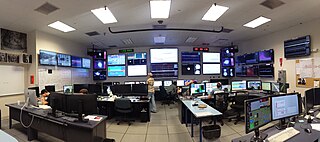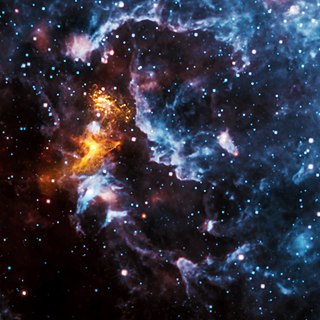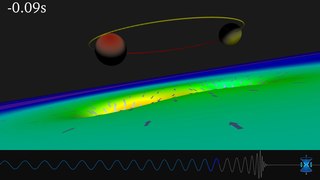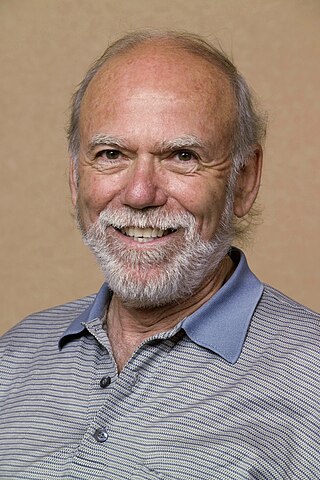
The Laser Interferometer Gravitational-Wave Observatory (LIGO) is a large-scale physics experiment and observatory designed to detect cosmic gravitational waves and to develop gravitational-wave observations as an astronomical tool. Two large observatories were built in the United States with the aim of detecting gravitational waves by laser interferometry. These observatories use mirrors spaced four kilometers apart which are capable of detecting a change of less than one ten-thousandth the charge diameter of a proton.

Kip Stephen Thorne is an American theoretical physicist known for his contributions in gravitational physics and astrophysics. Along with Rainer Weiss and Barry C. Barish, he was awarded the 2017 Nobel Prize in Physics for his contributions to the LIGO detector and the observation of gravitational waves.

A pulsar is a highly magnetized rotating neutron star that emits beams of electromagnetic radiation out of its magnetic poles. This radiation can be observed only when a beam of emission is pointing toward Earth, and is responsible for the pulsed appearance of emission. Neutron stars are very dense and have short, regular rotational periods. This produces a very precise interval between pulses that ranges from milliseconds to seconds for an individual pulsar. Pulsars are one of the candidates for the source of ultra-high-energy cosmic rays.

The Max Planck Institute for Gravitational Physics is a Max Planck Institute whose research is aimed at investigating Einstein's theory of relativity and beyond: Mathematics, quantum gravity, astrophysical relativity, and gravitational-wave astronomy. The institute was founded in 1995 and is located in the Potsdam Science Park in Golm, Potsdam and in Hannover where it closely collaborates with the Leibniz University Hannover. Both the Potsdam and the Hannover parts of the institute are organized in three research departments and host a number of independent research groups.

GEO600 is a gravitational wave detector located near Sarstedt, a town 20 km to the south of Hanover, Germany. It is designed and operated by scientists from the Max Planck Institute for Gravitational Physics, Max Planck Institute of Quantum Optics and the Leibniz Universität Hannover, along with University of Glasgow, University of Birmingham and Cardiff University in the United Kingdom, and is funded by the Max Planck Society and the Science and Technology Facilities Council (STFC). GEO600 is capable of detecting gravitational waves in the frequency range 50 Hz to 1.5 kHz, and is part of a worldwide network of gravitational wave detectors. This instrument, and its sister interferometric detectors, when operational, are some of the most sensitive gravitational wave detectors ever designed. They are designed to detect relative changes in distance of the order of 10−21, about the size of a single atom compared to the distance from the Sun to the Earth. Construction on the project began in 1995.
The gravitational wave background is a random background of gravitational waves permeating the Universe, which is detectable by gravitational-wave experiments, like pulsar timing arrays. The signal may be intrinsically random, like from stochastic processes in the early Universe, or may be produced by an incoherent superposition of a large number of weak independent unresolved gravitational-wave sources, like supermassive black-hole binaries. Detecting the gravitational wave background can provide information that is inaccessible by any other means about astrophysical source population, like hypothetical ancient supermassive black-hole binaries, and early Universe processes, like hypothetical primordial inflation and cosmic strings.

The Virgo interferometer is a large Michelson interferometer designed to detect gravitational waves predicted by general relativity. It is located in Santo Stefano a Macerata, near the city of Pisa, Italy. The instrument's two arms are three kilometres long, housing its mirrors and instrumentation inside an ultra-high vacuum.

Gravitational waves are waves of the intensity of gravity that are generated by the accelerated masses of binary stars and other motions of gravitating masses, and propagate as waves outward from their source at the speed of light. They were first proposed by Oliver Heaviside in 1893 and then later by Henri Poincaré in 1905 as the gravitational equivalent of electromagnetic waves. Gravitational waves are sometimes called gravity waves, but gravity waves typically refer to displacement waves in fluids. In 1916 Albert Einstein demonstrated that gravitational waves result from his general theory of relativity as ripples in spacetime.
Korea Electric Power Corporation, better known as KEPCO or Hanjeon, is the largest electric utility in South Korea, responsible for the generation, transmission and distribution of electricity and the development of electric power projects including those in nuclear power, wind power and coal. KEPCO, through its subsidiaries, is responsible for 93% of Korea's electricity generation as of 2011. The South Korean government owns a 51.11% share of KEPCO. Together with its affiliates and subsidiaries, KEPCO has an installed capacity of 65,383 MW. On the 2011 Fortune Global 500 ranking of the world's largest companies, KEPCO was ranked 271. KEPCO is a member of the World Energy Council, the World Nuclear Association and the World Association of Nuclear Operators. As of August 2011, KEPCO possesses an A+ credit rating with Fitch Ratings, while Moody's has assigned KEPCO an A1 stable rating.

A gravitational-wave detector is any device designed to measure tiny distortions of spacetime called gravitational waves. Since the 1960s, various kinds of gravitational-wave detectors have been built and constantly improved. The present-day generation of laser interferometers has reached the necessary sensitivity to detect gravitational waves from astronomical sources, thus forming the primary tool of gravitational-wave astronomy.
Einstein Telescope (ET) or Einstein Observatory, is a proposed third-generation ground-based gravitational wave detector, currently under study by some institutions in the European Union. It will be able to test Einstein's general theory of relativity in strong field conditions and realize precision gravitational wave astronomy.
A pulsar timing array (PTA) is a set of galactic pulsars that is monitored and analysed to search for correlated signatures in the pulse arrival times on Earth. As such, they are galactic-sized detectors. Although there are many applications for pulsar timing arrays, the best known is the use of an array of millisecond pulsars to detect and analyse long-wavelength gravitational wave background. Such a detection would entail a detailed measurement of a gravitational wave (GW) signature, like the GW-induced quadrupolar correlation between arrival times of pulses emitted by different millisecond pulsar pairings that depends only on the pairings' angular separations in the sky. Larger arrays may be better for GW detection because the quadrupolar spatial correlations induced by GWs can be better sampled by many more pulsar pairings. With such a GW detection, millisecond pulsar timing arrays would open a new low-frequency window in gravitational-wave astronomy to peer into potential ancient astrophysical sources and early Universe processes, inaccessible by any other means.
To help compare different orders of magnitude, the following list describes various voltage levels.
KEPCO E&C is a power plant design and engineering company in South Korea. It was established in 1975 as a public enterprise. KEPCO E&C engages in designing, engineering, and constructing nuclear and fossil power plants. The company operates as a subsidiary of Korea Electric Power Corporation (KEPCO).

Barry Clark Barish is an American experimental physicist and Nobel Laureate. He is a Linde Professor of Physics, emeritus at California Institute of Technology and a leading expert on gravitational waves.

LISA Pathfinder, formerly Small Missions for Advanced Research in Technology-2 (SMART-2), was an ESA spacecraft that was launched on 3 December 2015 on board Vega flight VV06. The mission tested technologies needed for the Laser Interferometer Space Antenna (LISA), an ESA gravitational wave observatory planned to be launched in 2035. The scientific phase started on 8 March 2016 and lasted almost sixteen months. In April 2016 ESA announced that LISA Pathfinder demonstrated that the LISA mission is feasible.

The Okawachi Pumped Storage Power Station is a large pumped-storage hydroelectric power station in Kamikawa Town in the Kanzaki District of Hyōgo Prefecture, Japan. With a total installed capacity of 1,280 megawatts (1,720,000 hp), it is one of the largest pumped-storage power stations in Japan. The facility is run by the Kansai Electric Power Company (KEPCO). The power plant started operation in October 1992 and all four units were commissioned by June 1995.

Kai Kruse Staats is a filmmaker, science researcher, writer, and entrepreneur.
Norna Robertson is a lead scientist at LIGO at California Institute of Technology, and professor of experimental physics at the University of Glasgow. Her career has focused on experimental research into suspension systems and instrumentation to achieve the detection of gravitational waves.

Rana X. Adhikari is an American experimental physicist. He is a professor of physics at the California Institute of Technology (Caltech) and an associate faculty member of the International Centre for Theoretical Sciences of Tata Institute of Fundamental Research (ICTS-TIFR).













